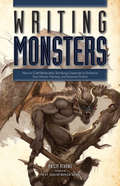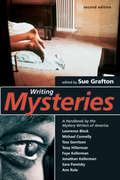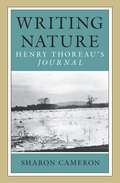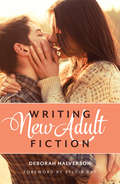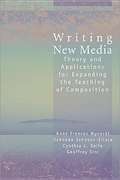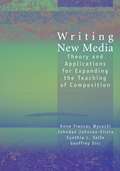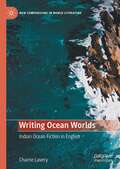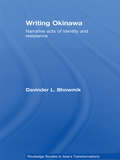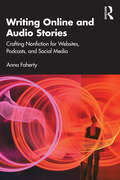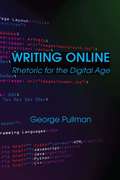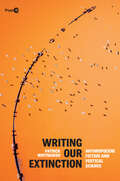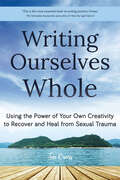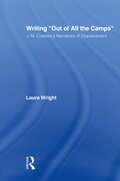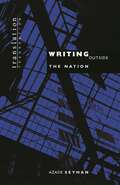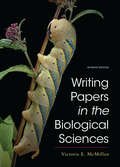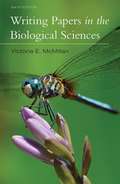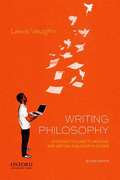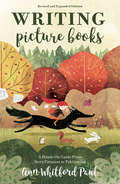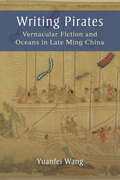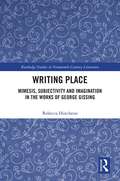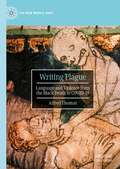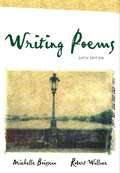- Table View
- List View
Writing Mobile Lives, 1500–1700 (Elements in Travel Writing)
by Eva Johanna HolmbergThis Element develops and showcases a new methodological framework in which to study the connections between early modern travel writing and life- and self-writing. Turning the scholarly focus in the study of travel writing from eye-witnessing and proto-ethnography of foreign lands to the 'fashioned' and portrayed selves and 'inner worlds' of travellers – personal memory, autobiographical practices, and lived yet often heavily mediated travel experiences – it opens up perspectives to travel writing in its many modes, that extend both before and after 'lived' travels into their many pre- and afterlives in textual form. This title is also available as Open Access on Cambridge Core.
Writing Monsters: How to Craft Believably Terrifying Creatures to Enhance Your Horror, Fantasy, an d Science Fiction
by Philip AthansMonsters are more than things that go bump in the night... Monsters are lurking in the woods, beneath the waves, and within our favorite books, films, and games--and there are good reasons why they appear so often. Monsters are manifestations of our fears and symbols of our society--not to mention they're a lot of fun--but each should serve a purpose and enhance the themes and tension in your fiction. In Writing Monsters, best-selling author Philip Athans uses classic examples from books, films, and the world around us to explore what makes monsters memorable--and terrifying. You'll learn what monsters can (and should) represent in your story and how to create monsters from the ground up. Writing Monsters includes: In-depth discussions of where monsters come from, what they symbolize, and how to best portray them in fiction Informative overviews of famous monsters, archetypes, and legendary creatures A Monster Creation Form to help you create your monster from scratch An annotated version of H.P. Lovecraft's chilling story "The Unnamable" Whether you write fantasy, science fiction, or horror, your vampires, ghouls, aliens, and trolls need to be both compelling and meaningful. With Writing Monsters, you can craft creatures that will wreak havoc in your stories and haunt your readers' imaginations--and nightmares.
Writing Mysteries for Young People
by Joan Lowery NixonJoan Lowery covers each aspect of writing mysteries, in easy-to-follow steps and provides many examples for each. All the information a writer needs to know is there. Learn what a "plant" is. Make a chart to show where all characters are at any given moment in the course of the mystery so alert readers are satisfied there is no cheating.
Writing Mysteries: A Handbook by the Mystery Writers of America (2nd edition)
by Sue GraftonHere's your ticket to the greatest mystery-writing workshop ever!In this extraordinary compilation, more than three dozen members of the Mystery Writers of America share insights and advice that can help make your writing dreams a reality.You'll learn how to:Develop unique ideasConstruct an airtight plot packed with intrigue and suspenseCreate compelling characters and atmospheric settingsDevelop a writing style all your ownWrite convincing dialogueChoose the appropriate point of viewWork with an agentConduct accurate researchand much, much more! You'll also find special guidelines for creating clues, dropping red herrings, and writing medical, legal, historical, true crime, and young adult mysteries. It's all the information you need to solve the mystery-writing riddle!
Writing Nature: Henry Thoreau's Journal
by Sharon CameronAt his death, Henry Thoreau left the majority of his writing unpublished. The bulk of this material is a journal that he kept for twenty-four years. Sharon Cameron's major claim is that this private work (the Journal) was Thoreau's primary work, taking precedence over the books that he published in his lifetime. Her controversial thesis views Thoreau's Journal as a composition that confounds the distinction between public and private--the basis on which our conventional treatment of discourse depends.
Writing New Adult Fiction: How to Write and Sell New-Adult Fiction
by Deborah HalversonJoin the New Adult Fiction revolution! From Sylvia Day's Bared to You to Jamie McGuire's Beautiful Disaster, new adult fiction has arrived--and it's hotter than ever. But there's more to this category than its 18-to-26-year-old characters: The success of your story depends on authentically depicting the transition of your young protagonists from teenhood to adulthood. With Writing New Adult Fiction, you'll learn how to capture the spirit of freedom, self-discovery, and romance that defines the new adult experience. Create memorable characters that act and sound like new adults. Sculpt a distinct personality for your fiction with POV, voice, tone, and word choices. Build a unique, captivating plot that satisfies your audience from beginning to end. Learn tools for revising effectively and efficiently in a speed-driven market. Weigh the options for your path to publication: traditional, indie, and hybrid. The new adult category is filled with opportunities to break in with distinct plots and original characters. Make your mark by writing a novel that's fresh, unique--and wholly new adult!
Writing New Media
by Anne WysockiAs new media mature, the changes they bring to writing in college are many and suggest implications not only for the tools of writing, but also for the contexts, personae, and conventions of writing. An especially visible change has been the increase of visual elements-from typographic flexibility to the easy use and manipulation of color and images. Another would be in the scenes of writing-web sites, presentation "slides," email, online conferencing and coursework, even help files, all reflect non-traditional venues that new media have brought to writing. By one logic, we must reconsider traditional views even of what counts as writing; a database, for example, could be a new form of written work. The authors of Writing New Media bring these ideas and the changes they imply for writing instruction to the audience of rhetoric/composition scholars. Their aim is to expand the college writing teacher's understanding of new media and to help teachers prepare students to write effectively with new media beyond the classroom. Each chapter in the volume includes a lengthy discussion of rhetorical and technological background, and then follows with classroom-tested assignments from the authors' own teaching.
Writing New Media: Theory and Applications for Expanding the Teaching of Composition
by Anne WysockiAs new media mature, the changes they bring to writing in college are many and suggest implications not only for the tools of writing, but also for the contexts, personae, and conventions of writing. An especially visible change has been the increase of visual elements-from typographic flexibility to the easy use and manipulation of color and images. Another would be in the scenes of writing-web sites, presentation "slides," email, online conferencing and coursework, even help files, all reflect non-traditional venues that new media have brought to writing. By one logic, we must reconsider traditional views even of what counts as writing; a database, for example, could be a new form of written work. The authors of Writing New Media bring these ideas and the changes they imply for writing instruction to the audience of rhetoric/composition scholars. Their aim is to expand the college writing teacher's understanding of new media and to help teachers prepare students to write effectively with new media beyond the classroom. Each chapter in the volume includes a lengthy discussion of rhetorical and technological background, and then follows with classroom-tested assignments from the authors' own teaching.
Writing Occupation: Jewish Émigré Voices in Wartime France (Stanford Studies in Jewish History and Culture)
by Julia ElskyAmong the Jewish writers who emigrated from Eastern Europe to France in the 1910s and 1920s, a number chose to switch from writing in their languages of origin to writing primarily in French, a language that represented both a literary center and the promises of French universalism. But under the Nazi occupation of France from 1940 to 1944, these Jewish émigré writers—among them Irène Némirovsky, Benjamin Fondane, Romain Gary, Jean Malaquais, and Elsa Triolet—continued to write in their adopted language, even as the Vichy regime and Nazi occupiers denied their French identity through xenophobic and antisemitic laws. In this book, Julia Elsky argues that these writers reexamined both their Jewishness and their place as authors in France through the language in which they wrote. The group of authors Elsky considers depicted key moments in the war from their perspective as Jewish émigrés, including the June 1940 civilian flight from Paris, life in the occupied and southern zones, the roundups and internment camps, and the Resistance in France and in London. Writing in French, they expressed multiple cultural, religious, and linguistic identities, challenging the boundaries between center and periphery, between French and foreign, even when their sense of belonging was being violently denied.
Writing Ocean Worlds: Indian Ocean Fiction in English (New Comparisons in World Literature)
by Charne LaveryThis book explores the Indian Ocean world as it is produced by colonial and postcolonial fiction in English. It analyses the work of three contemporary authors who write the Indian Ocean as a region and world—Amitav Ghosh, Abdulrazak Gurnah, and Lindsey Collen—alongside maritime-imperial precursor Joseph Conrad. If postcolonial literatures are sometimes read as national allegories, this book presents an account of a different and significant strand of postcolonial fiction whose geography, in contrast, is coastal and transoceanic. This work imaginatively links east Africa, south Asia and the Arab world via a network of south-south connections that precedes and survives European imperialism. The novels and stories provide a vivid, storied sense of place on both a local and an oceanic scale, and in so doing remap the world as having its centre in the ocean and the south.
Writing Okinawa: Narrative acts of identity and resistance (Routledge Studies in Asia's Transformations)
by Davinder L. BhowmikWriting Okinawa is the first comprehensive study in English of Okinawan fiction, from it’s emergence in the early twentieth-century through its most recent permutations. It provides readings of major authors and texts set against a carefully researched presentation of the region’s political and social history; at the same time, it thoughtfully engages with current critical perspective with perspectives on subaltern identity, colonialism, and post-colonialism, and the nature of "regional," "minority," and "minor" literatures. Is Okinawan fiction, replete with geographically specific themes such as language loss, identity, and war, a regional literature, distinct among Japanese letters for flourishes of local color that offer a reprieve for the urban-weary, or a minority literature that serves as a site for creative resistance and cultural renewal? This question drives the book’s argument, making it interpretative rather than merely descriptive. Not only does the book provide a critical introduction to the major works of Okinawan literature, it also argues that Okinawa’s writers consciously exploit, to good effect the overlap that exists between regional and minority literature. In so doing, they produce a rich body of work, a great deal of which challenges the notion of a unified nation that seamlessly rises from a single language and culture.
Writing Online and Audio Stories: Crafting Nonfiction for Websites, Podcasts, and Social Media
by Anna FahertyGuiding readers through the unique challenges and choices presented by digital publication, this book provides a practical set of tools to help students, creatives, and content professionals craft emotionally engaging nonfiction stories for online readers and listeners. From considering what story to tell, to bringing narratives to life in practice, Anna Faherty explains what gives stories their unique power and demonstrates how to successfully combine techniques from short-stories and screenwriting with journalistic practices like fact checking and verification. Examples from corporate websites, personal blogs, podcasts, and social media set out how to attract and involve readers and listeners, and how to prompt them to take action. Readers will come away with a straightforward framework for planning and crafting storytelling projects and an understanding of text and script development, copyright, and editing. Each chapter includes summaries of key principles and practical writing tips, while case studies share insights from writers’ professional practices – including those who use storytelling to influence customers or advocate for change. Writing Online and Audio Stories is a valuable entry-point for creative writers, podcasters, and professionals in PR and marketing, as well as students undertaking courses such as Digital Writing, Creative Nonfiction and Multimedia Storytelling.
Writing Online: Rhetoric for the Digital Age
by George Pullman"Contrary to the old adage about finding new names for old things, Writing Online: Rhetoric for the Digital Age gives new life and new meaning to old names. The book and its companion website transform ancient rhetoric as a process of oral composition--invention, arrangement, memory, style, and delivery--into a digital rhetoric, a dynamic process of writing for the World Wide Web: dynamic because it shows not only how to write in a Web-based medium but, more importantly, how to learn and adapt to a medium that is constantly evolving and changing. Unlike conventional books that provide specific solutions to specific problems, Writing Online reenacts the process of solving Web-based writing problems, explaining everything from how to create a simple web page to how to develop a sophisticated content management system and everything in between: HTML, HTML5, CSS, JavaScript, PHP, and much more. As a digital rhetoric, moreover, Writing Online recreates the ancient processes of oral composition for a digital era. Digital invention becomes a push-pull process of transmitting information via searches, alerts, news aggregators, and read-write algorithms. Digital arrangement becomes a question-and-answer process inviting multiple responses via intuitive navigation systems and dynamic patterns of organization. Digital memory transforms the ancient memory palace into a dynamic, programmable content management system. Digital style provides computer-based tools to enhance writers' word choice, argumentative structures, and feedback. Digital delivery resituates speakers and writers in onscreen environments that balance functionality and aesthetics for optimum responsiveness and usability." --James P. Zappen, Professor, Department of Communication and Media, Rensselaer Polytechnic Institute
Writing Our Extinction: Anthropocene Fiction and Vertical Science (Post*45)
by Patrick WhitmarshMid-twentieth-century developments in science and technology produced new understandings and images of the planet that circulated the globe, giving rise to a modern ecological consciousness; but they also contributed to accelerating crises in the global environment, including climate change, pollution, and waste. In this new work, Patrick Whitmarsh analyzes postwar narrative fictions that describe, depict, or express the earth from above (the aerial) and below (the subterranean), revealing the ways that literature has engaged this history of vertical science and linked it to increasing environmental precarity, up to and including the extinction of humankind. Whitmarsh examines works by writers such as Don DeLillo, Karen Tei Yamashita, Reza Negarestani, and Colson Whitehead alongside postwar scientific programs including the Space Race, atmospheric and underground nuclear testing, and geological expeditions such as Project Mohole (which attempted to drill to the earth's mantle). As Whitmarsh argues, by focusing readers' attention on the fragility of postwar life through a vertical lens, Anthropocene fiction highlights the interconnections between human behavior and planetary change. These fictions situate industrial history within the much longer narrative of geological time and reframe scientific progress as a story through which humankind writes itself out of existence.
Writing Ourselves Whole: Using the Power of Your Own Creativity to Recover and Heal from Sexual Trauma
by Jen Cross#1 Best Seller in Obsessive Compulsive Disorder (OCD) and Study Aids - A Book That Will Change Your LifeHealing victims of sexual assault through transformative journaling. One in six women is the victim of sexual assault. Using her own hard-won wisdom, author Jen Cross shows how to heal through journaling and personal writingRape victims and victims of other sexual abuse. Writing Ourselves Whole is a collection of essays and creative writing encouragements for sexual trauma survivors who want to risk writing a different story. Each short chapter offers encouragement, experience, and exercises.How to change your life. When you can find language for the stories that are locked inside, you can change your life. Talk therapy can only go so far for the millions of Americans struggling in the aftermath of sexual abuse and sexual assault. Sexual assault survivors can heal themselves. Sexual trauma survivor communities (and their allies) have the capacity to hold and hear one another's stories–we do not have to relegate ourselves solely to the individual isolation of the therapist's office.What You'll Learn Inside Writing Ourselves Whole:How to reconnect with your creative instinct through freewritingHow freewriting can help you reclaim the parts of yourself and your historyHow "restorying" the old myths about sexual trauma survivors can set you freeIf you have read books such as Julia Cameron's The Artist's Way, Natalie Goldberg's Writing Down the Bones, or Louise DeSalvo's Writing as a Way of Healing, your will want to read Writing Ourselves Whole.
Writing Out of All the Camps: J.M. Coetzee's Narratives of Displacement (Studies in Major Literary Authors)
by Laura WrightWriting "Out of all the Camps": J. M. Coetzee's Narratives of Displacement is an interdisciplinary examination--combining ethical, postcolonial, performance, gender-based, and environmental theory--of the ways that 2003 Nobel Prize-winning South African novelist J. M. Coetzee, primarily through his voicing of a female subject position and his presentation of a voiceless subjectivity, the animal, displaces both the narrative and authorial voice in his works of fiction. Coetzee's work remains outside of conventional notions of genre by virtue of the free indirect discourse that characterizes many of his third-person narrated texts that feature male protagonists (Life & Times of Michael K, The Master of Petersburg, and Disgrace), various and differing first-person narrative accounts of the same story (Dusklands, In the Heart of the Country), the use of female narrators and female narrative personas (Age of Iron, The Lives of Animals), and unlocatable, ahistorical contexts (Waiting for the Barbarians). The work has broad academic appeal in the established fields of not only literary studies--postcolonial, contemporary, postmodern and environmental--but also in the realm of performance and gender studies. Because of its broad and interdisciplinary range, this text bridges a conspicuous gap in studies on Coetzee.
Writing Outside the Nation (Translation/Transnation #31)
by Azade SeyhanSome of the most innovative writers of contemporary literature are writing in diaspora in their second or third language. Here Azade Seyhan describes the domain of transnational poetics they inhabit. She begins by examining the works of selected bilingual and bicultural writers of the United States (including Oscar Hijuelos, Maxine Hong Kingston, and Eva Hoffman) and Germany (Libuse Moníková, Rafik Schami, and E. S. Özdamar, among others), developing a new framework for understanding the relationship between displacement, memory, and language. Considering themes of loss, witness, translation, identity, and exclusion, Seyhan interprets diasporic literatures as condensed archives of cultural and linguistic memory that give integrity and coherence to pasts ruptured by migration. The book next compares works by contemporary Chicana and Turkish-German women writers as innovative and sovereign literary voices within the larger national cultures of the United States and Germany. Seyhan identifies in American multiculturalism critical clues for analyzing new cultural formations in Europe and maintains that Germany's cultural transformation suggests new ways of reading the American literary mosaic. Her approach, however, extends well beyond these two literatures. She creates a critical map of a "third geography," where a transnational, multilingual literary movement is gathering momentum. Writing Outside the Nation both contributes to and departs from postcolonial studies in that it focuses specifically on transnational writers working outside of their "mother tongue" and compares American and German diasporic literatures within a sophisticated conceptual framework. It illustrates how literature's symbolic economy can reclaim lost personal and national histories, as well as connect disparate and distant cultural traditions.
Writing Papers in the Biological Sciences
by Victoria E. McMillanWritten by a professional biologist and experienced writing teacher, this comprehensive guide for students provides detailed instruction on researching, drafting, revising, and documenting lab reports, research papers, reviews, poster presentations, and other commonly assigned projects in biology courses. The seventh edition features updated coverage of research methods and new student examples from a wider variety of sub-disciplines in biology that support students at all levels of biology.
Writing Papers in the Biological Sciences
by Victoria E. McmillanWritten by a professional biologist who is also an experienced writing teacher, this comprehensive guide for students writing in biology, zoology, and botany provides detailed instruction on researching, drafting, revising, and documenting papers, reviews, poster presentations, and other forms of science writing. The sixth edition features an expanded and revised chapter 1 on research strategies and sources, a greater diversity of examples from different subdisciplines (molecular biology, animal ecology, and genetics), and new technology tips throughout for searching databases and using software designed for charts, graphs, note-taking, and documentation.
Writing Philosophy: A Student's Guide to Reading and Writing Philosophy Essays
by Lewis VaughnThis second edition of Writing Philosophy, aspires to help philosophy teachers address a big problem--the conflict between trying to teach course content and dealing with students who are ill prepared to write papers on that content. The dilemma is acute because writing is both a valuable teaching tool and a vehicle for assessing understanding. Using class time to explain the unique demands of philosophical writing, however, can divert time and attention from the real meat of a course. This book tries to come as close as possible to the ideal of a brief, self-guided manual that covers the basics of argumentative essay writing and encourages rapid learning with minimal teacher input.
Writing Picture Books Revised and Expanded Edition: A Hands-On Guide From Story Creation to Publication
by Ann Whitford PaulMaster the Art of Writing Enthralling Tales for the Youngest pre-and emerging readers! Fully updated and thoroughly revised, Writing Picture Books Revised and Expanded Edition is the go-to resource for writers crafting stories for children ages two to eight. You'll learn the unique set of skills it takes to bring your story to life by using tightly focused text and leaving room for the illustrator to be creative. Award-winning author Ann Whitford Paul helps you develop the skills you need by walking you through techniques and exercises specifically for picture book writers. You'll find:Instruction on generating ideas, creating characters, point-of-view, beginnings and endings, plotting, word count, rhyme, and moreUnique methods for using poetic techniques to enrich your writingHands-on revision exercises (get out your scissors, tape, and highlighters) to help identify problems and improve your picture book manuscriptsUpdated tips for researching the changing picture book market, approaching publishers, working with an agent, and developing a platformAll new quizzes and examples from picture books throughoutNew chapters cover issues such as page turns, agents, and self-publishingWhether you're just starting out as a picture book writer or have tried unsuccessfully to get your work published, Writing Picture Books Revised and Expanded Edition is just what you need to craft picture books that will appeal to young children and parents, and agents and editors.
Writing Pirates: Vernacular Fiction and Oceans in Late Ming China
by Yuanfei WangIn Writing Pirates, Yuanfei Wang connects Chinese literary production to emerging discourses of pirates and the sea. In the late Ming dynasty, so-called “Japanese pirates” raided southeast coastal China. Hideyoshi invaded Korea. Europeans sailed for overseas territories, and Chinese maritime merchants and emigrants founded diaspora communities in Southeast Asia. Travel writings, histories, and fiction of the period jointly narrate pirates and China’s Orient in maritime Asia. Wang shows that the late Ming discourses of pirates and the sea were fluid, ambivalent, and dialogical; they simultaneously entailed imperialistic and personal narratives of the “other”: foreigners, renegades, migrants, and marginalized authors. At the center of the discourses, early modern concepts of empire, race, and authenticity were intensively negotiated. Connecting late Ming literature to the global maritime world, Writing Pirates expands current discussions of Chinese diaspora and debates on Sinophone language and identity.
Writing Place: Mimesis, Subjectivity and Imagination in the Works of George Gissing (Routledge Studies in Nineteenth Century Literature)
by Rebecca HutcheonExploring a hitherto neglected field, Writing Place: Mimesis, Subjectivity and Imagination in the Works of George Gissing is the first monograph to consider the works of George Gissing (1857-1903) in light of the ‘spatial turn’. By exploring how objectivity and subjectivity interact in his work, the book asks: what are the risks of looking for the ‘real’ in Gissing’s places? How does the inherent heterogeneity of Gissing’s observation influence the textual recapitulation of place? In addition to examining canonical texts such as The Nether World (1889), New Grub Street (1891), and The Private Papers of Henry Ryecroft (1901), the book analyses the lesser-known novels, short stories, journalism and personal writings of Gissing, in the context of modern spatial studies. The book challenges previously biographical and London-centric accounts of Gissing’s representation of space and place by re-examining seemingly innate contemporaneous geographical demarcations such as the north and the south, the city, suburb, and country, Europe and the world, and re-reading Gissing’s places in the contexts of industrialism, ruralism, the city in literature, and travel writing. Through sustained attention to the ambiguities and contradictions rooted in the form and content of his writing, the book concludes that, ultimately, Gissing’s novels undermine spatial dichotomies by emphasising and celebrating the incongruity of seeming certainties
Writing Plague: Language and Violence from the Black Death to COVID-19 (The New Middle Ages)
by Alfred ThomasWriting Plague: Language and Violence from the Black Death to COVID-19 brings a holistic and comparative perspective to “plague writing” from the later Middle Ages to the twenty-first century. It argues that while the human “hardware” has changed enormously between the medieval past and the present (urbanization, technology, mass warfare, and advances in medical science), the human “software” (emotional and psychological reactions to the shock of pandemic) has remained remarkably similar across time. Through close readings of works by medieval writers like Guillaume de Machaut, Giovanni Boccaccio, and Geoffrey Chaucer in the fourteenth century, select plays by Shakespeare, and modern “plague” fiction and film, Alfred Thomas convincingly demonstrates psychological continuities between the Black Death and COVID-19. In showing how in times of plague human beings repress their fears and fantasies and displace them onto the threatening “other,” Thomas highlights the danger of scapegoating vulnerable minority groups such as Asian Americans and Jews in today’s America. This wide-ranging study will thus be of interest not only to medievalists but also to students of modernity as well as the general reader.
Writing Poems (6th edition)
by Michelle Boisseau Robert WallaceThis book offers comprehensive coverage of the creative process and the technical aspects of writing poetry.

